Boston Terrier versus French Bulldog: What’s the difference?
BGIDW won't tell you who's cuter, just how to tell the two breeds apart
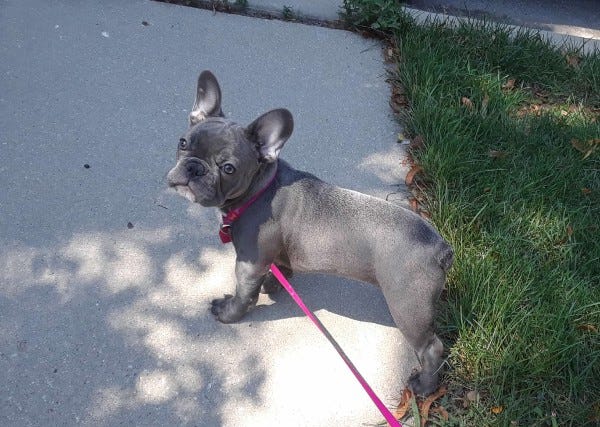
Writer’s note: This was originally published on July 23, 2020 at the now-defunct website Dog Struggles. It has been lightly edited for technical details and readability. (If you’re interested in reading pet-related top 10-, 15- and 20 listicles from me that were also featured on the site, click here.)
Maybe it’s the pointy ears or the squishy nose that’ll win you over. Maybe it’s those little legs that can somehow maneuver their way around any baby gate or other blockades you could set up. Or, maybe it’s those bright, curious eyes that look up at you just begging you to scoop these little dogs up.
You walk into a reputable pet store and see both. Boston Terrier vs. French Bulldog: Who’s cuter? Now that one can be a pretty difficult decision to make.
Instead, let’s speculate on topics that aren’t just a matter of fabulous Christmas postcards and smartphone lock screens. Which breed is better for your house or apartment? Which breed has a better temperament for a small living space, or a large one? In the blog below, you’ll find out the answers to these questions and more.
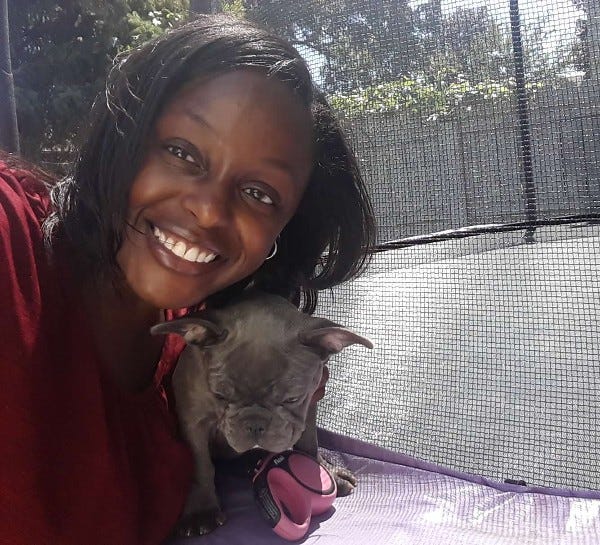
You’ll learn similarities and differences between the heights of Boston Terriers and French Bulldogs, what their build is, how long they’ll live, their temperament, any health concerns, and a host of other things.
ADVERTISEMENT ~ Amazon
As an Amazon affiliate, I earn a percentage from purchases with my referral links. I know some consumers are choosing to boycott Amazon for its DEI removal. However, after thinking about this thoroughly, I choose to continue promoting intriguing products from small businesses, women-owned businesses and (specifically) Black-owned businesses who still feature their items on Amazon. All five of my Substack publications now include a MINIMUM of one product sold by a Black-owned business. (I have visited the seller’s official site, not just the Amazon Black-owned logo, to verify this.) If you still choose to boycott, I 100% respect that decision.
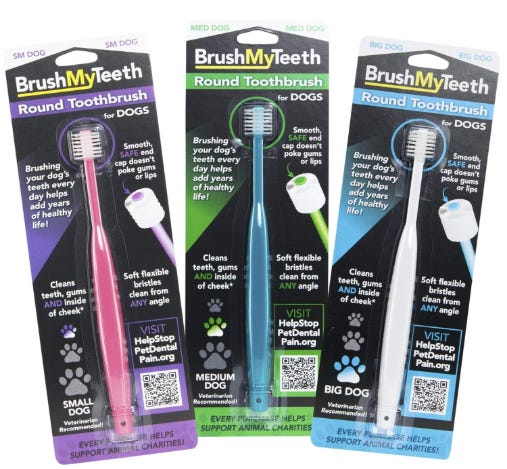
The origin story: Where do Boston Terriers and French Bulldogs originate?
The Boston Terrier is a crossbreed between the English Bulldog and the now-extinct White English Terrier. According to the book “The Boston Terrier,” along with archives from the Boston Terrier Club of America, Inc., the earliest traces of this crossbreed link back to a male dog named Judge (an English bulldog and a white English Terrier with dark brindle fur) from England.
In 1870, Judge was brought from England to Boston, where he was given the nickname “Hooper’s Judge” because his owner’s name was Robert C. Hooper. Hooper’s Judge mated with a white female dog named Gyp. From Gyp came Eph, the latter of which mated with Kate. Originally called a “Round Head,” in later years, the crossbreed was renamed the Boston Terrier.
French Bulldogs were a hit in the 1800s, too, in English cities. Lace makers in Nottingham embraced the fun-size Bulldogs and relocated to northern France for professional reasons.
According to the American Kennel Club, the Bulldogs were later bred with other small dogs such as Terriers and Pugs, which gave them their recognizable pointy “bat” ears. Originally called Bouledogue Francais, their popularity from Parisian dance halls and Paris cafes spread to America by the end of the 19th century.
How big are Boston Terriers and French Bulldogs?
These little pups are easy to scoop up like puppies, weighing less than 5 pounds in the very early months. The Boston Terrier has a slight edge over French Bulldogs at adult height and build. Boston Terriers on average weigh 12 to 25 pounds and are 15 to 17 inches tall. French Bulldogs can weigh under 28 pounds but are smaller than the first breed, standing at 11 to 13 inches.
Major differences in appearance for Boston Terriers and French Bulldogs?
Both non-sporting breeds have those recognizable ears and smushed-in nose. The “Boston Gentleman” (i.e. Boston Terrier) usually has a “tuxedo coat” — primarily black and white, in addition to brindle (a Tiger-like print) or seal (black with a red glow in the sun). Their heads are square. And their short muzzles make Boston Terrier’s large, round eyes stand out even more.
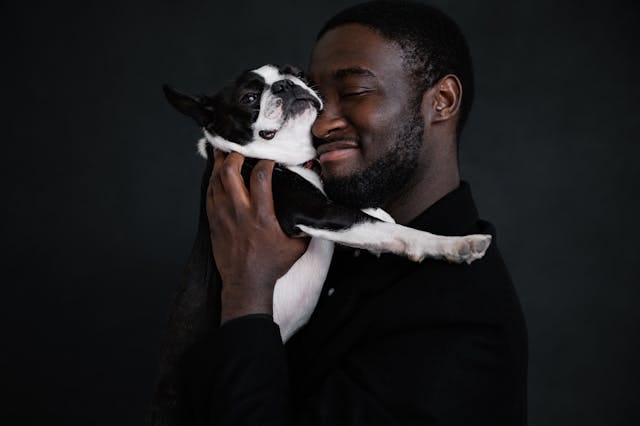
Shrink a purebred Bulldog and hold his ears up in the air, and you’ll see the results of a French Bulldog. Also, with large “bat ears” like the Boston Terrier, their heads are large and square. However, there are far more wrinkles on the flat faces of French Bulldogs, specifically near the short nose.
They come in a wide variety of colors — brindle, gray, white or eggshell colors, tan, blue-fawn brindles, blue brindles, chocolate brown, and black.
How can you tell a French Bulldog from a Boston Terrier?
While both of these breeds’ ears shoot straight up, French Bulldogs have ears that are slightly rounded like bat ears. (Thanks to Americans who were smitten with these pointy years, the breed has kept them even though the English would’ve largely preferred the rose ears of the purebred Bulldog.)
Boston Terriers’ ears are a bit more narrow. The jawline of a French Bulldog also makes their heads look more square than round in comparison to the Boston Terrier’s slightly oval face.
Their snouts, on the other hand, are quite similar. They’re both black and short snoots with a black line down the middle. The wrinkles around the nose make the French Bulldog’s nose appear small though.
Both dogs tend to have nubs for tails and are set low. The French Bulldog, specifically, usually has a tail so short that it almost appears to not even be there.
Is a French Bulldog easier to groom than a Boston Terrier?
Get ready to call a groomer or learn how to trim either of these breeds’ nails because both of them need regular nail clippings. Overly long nails will make it uncomfortable for them to walk or run, and both tend to walk with purpose in short, rapid steps.
Although neither dog is overly hairy, there are some basic grooming goals that need to be met. The Boston Terrier sheds far less than the French Bulldog. A soft-bristle brush, rubber grooming tool, or a hound glove raked through the Boston Terrier’s coat works fine to remove loose hair.
Get used to a weekly routine to evenly distribute skin oil and maintain hair growth. Bathing every four to six weeks is sufficient, maybe more or less depending on how frisky this pup is outside.
The French Bulldog, who sheds regularly, needs a slightly stronger brush to maintain a healthy coat and distribute skin oils. Use a medium bristle brush, rubber grooming tool, or a hound glove with this one. Bathing the French Bulldog can also be occasional.
However, make sure to get in between the dog facial wrinkles too. They should be both clean and dry to prevent bacterial infections or environmental irritants. Due to the French Bulldog’s heightened skin concerns due to those facial folds, it’s not a bad idea to check and clean their faces weekly.

What health concerns should be known about French Bulldogs and Boston Terriers?
Both of these brachycephalic breeds, along with Pugs and Bulldogs, can experience difficulty breathing without adequate shelter and in excessively humid environments. A short walk, outdoor play, or canine sports such as obedience are sufficient to keep French Bulldogs active and in shape.
They tend to be a reasonably energetic bunch but don’t need an abundance of daily activity. They’ll usually run around in the backyard a little bit before they tire.
While the Boston Terrier may need a bit more exercise to avoid boredom and mischievous behavior, obedience and agility games work well with this breed, too. A short walk or hanging outside for a little while is sufficient, too.
But keep in mind that even in its own breed, every dog is different. Some Boston Terriers and French Bulldogs may need more exercise than others. Once you develop a routine with this dog, though, it’s a good idea to keep it going consistently. So make sure you have the appropriate harness.
Both breeds get very sleepy after long walks or exercise so make sure you have a comfortable bed or crate ready for them to sleep/nap in.
Neither dog can swim naturally and without constant supervision due to their breathing issues. Even when bathing these breeds, be careful of how either breed is breathing in the water. Or, just hold the dogs and hand wash them.
As big and bright as those eyes are, keep a watchful eye over those Boston Terrier eyes. Take note of any signs of redness or irritation to avoid potential risks of cataracts, corneal ulcers, or glaucoma.
French Bulldogs may also be at higher risk of eye health concerns such as cherry eye, entropion, or juvenile cataracts. These flat-faced breeds are also more sensitive to anesthesia so triple check with your veterinarian before any major health procedure occurs.
Keep an observant eye on their gait, too. Medial Patella Luxation (MPL) in Bulldog puppies and adults is a common disorder. By default, this carries over into French Bulldogs. Look for signs of hopping or a hunched-over stance that seems odd compared to how the dog usually walks.
Both dogs can live anywhere from 10 to 13 years, so expect to have a long-time friend as long as this pup’s health concerns are taken care of and provided you feed the right food to them from puppy to adulthood.
ADVERTISEMENT ~ Amazon
As an Amazon Affiliate, I earn a percentage for each purchase with my referral links.
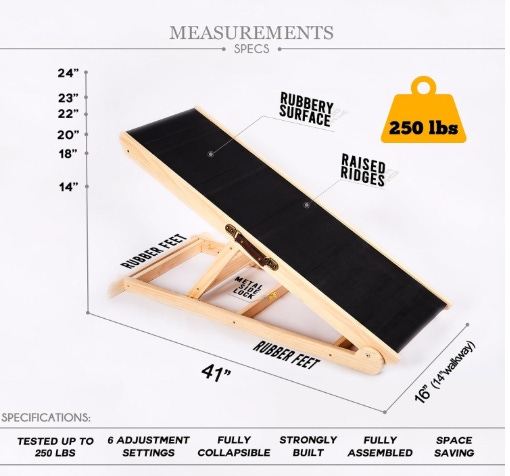

French Bulldog vs. Boston Terrier: Who has a better temperament?
While the Boston Terrier’s outgoing and eager-to-please disposition makes him a joy to be around, this also means he likes attention — a lot. This is not the kind of dog who can be left alone for hours on end during a long work shift. Consider hiring a dog walker or delegating family members and friends to keep a Boston Terrier company should the main owner be unavailable.
The French Bulldog is just as easy to train and likes to please his owners, but he can be stubborn when he wants to be. French Bulldogs may take a bit more time to train. Socializing both dogs early and often, along with puppy training classes, can make the training process much easier.
One of the biggest differences in training the two is their reaction to training. French Bulldogs, who tend to be adorable but cunning, often need more time to be civilized companions. Put up a baby gate and expect them to wiggle their way around it. Don’t be surprised when the door lock on the gate is suddenly unlatched, and the French Bulldog is hanging out near you.
These little ones are masters at the getaway plan, if only for the fun of showing you that they can roam free if they choose. They’re also perceptive enough to know when they’ve done something “wrong” and will usually dart back off to their dog spaces. Don’t be surprised if your French Bulldog catches on to paper training and other dog training techniques fairly easily.
Boston Terriers are also playful, but they often prioritize making their owners happier more than their own self-gratification. While the French Bulldog likes the sport of training and the occasional treat, Boston Terriers can take it personally if reprimanded for not catching on to training quick enough. Gentle corrections and plenty of praise work best for this breed.
For dog owners who want to incorporate treats into the training process, use them sparingly. In such small bodies, they can pack on weight fast, which only leads to potentially more breathing issues should it become more difficult for them to walk it off. For that reason, table scraps should be avoided too.
Bottom Line
Whether you choose a French Bulldog or a Boston Terrier as your next pet, you simply can’t go wrong with either. With similar features and similar health concerns, arguably you could save yourself the tiebreaker and get one of both. To be fair though, due to the health concerns of brachycephalic dogs such as these two, they can be on the pricier side when it comes to health conditions.
If you’re a light sleeper, prepare yourself for loud snoring, noisy breathing, and an almost-baby-cry when you are out of their sight. While these dogs are small, they are anything but shy or quiet. Although they are more prone to respiratory problems, that has barely decreased their popularity.
Why? First of all, they’re fun and playful companions. Secondly, the aesthetics of those rounder jawbones and fuzzy faces tend to take on the appearance of chubby babies. It’s difficult not to love these little pups in spite of their health risks. They look so cute in little accessories like a hoodie also.
As long as you know what you’re getting into and are prepared for the health and grooming needs of either of these breeds, you’ve found yourself a long-time companion. This pup does well in apartments and condos where he has enough room to move around and play but not enough to hurt himself. In houses, it’s a good idea to find one room that is his.
While neither needs the kind of massive playing space as larger, active breeds such as a German Shepherd or Labrador Retriever, it’s not a bad idea to give them enough room to breathe and stretch out a crate or dog bed. And when they’re ready, they have no problems snuggling up to you wherever you are, too.
Shamontiel is a dog lover to her core: 604 completed walks with 99 dogs, eight dog-housesittings and six dog boardings at the time of this publication.
Did you enjoy this post? You’re also welcome to check out my Substack columns “Black Girl In a Doggone World,” “BlackTechLogy,” “Homegrown Tales,” “I Do See Color,” “One Black Woman’s Vote” and “Window Shopping” too. Subscribe to this newsletter for the weekly posts every Wednesday. Thanks for reading!




